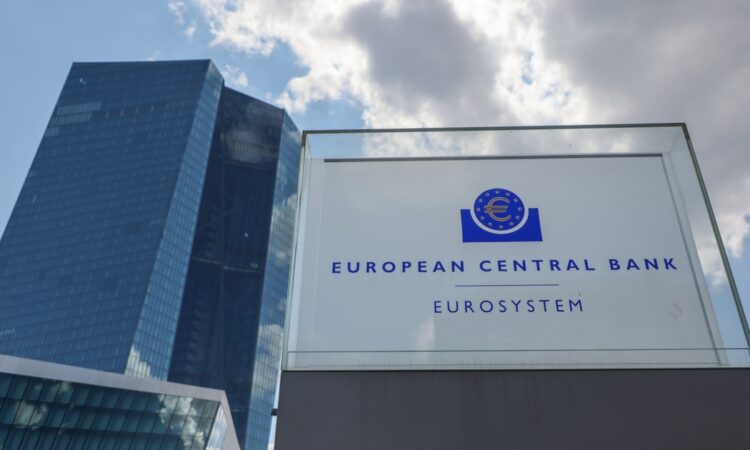
The Federal Reserve left rates unchanged on June 14 for the first time since March 2022. And while the European Central Bank delivered another 25-basis-point rate increase a day later, it is also expected to be close to the end of its interventions in the eurozone.
But sources said that European investors are having to keep a close eye on their portfolios’ inflation sensitivity because central banks were late to raise rates following the COVID-19 pandemic and will be late to cut them because of the energy crisis.
The tightening, which slows demand, combined with labor shortages and deglobalization trends, could result in the supply curve becoming less flexible — meaning that any change in demand would yield an inflation spike, sources said.
Headline inflation will average 5.4% in 2023 and drop to 3% in 2024, falling to 2.2% in 2025, according to ECB estimates.
While the ECB predicts that overall headline inflation will come down further as soon as next year, investors in Europe are evaluating which asset classes could help them shield portfolios from any unpredictable inflationary spikes. They said that a combination of equity, real assets, inflation-linked bonds and precious metals could do the job in the current environment.
“Volatility of inflation is on the rise,” said Luca Paolini, London-based chief strategist at the 219 billion Swiss francs ($244 billion) manager Pictet Asset Management. Therefore, he said, it is wise for investors to hold on to inflation-protection strategies such as inflation-linked Treasuries. Mr. Paolini said that depending on an investor’s risk profile, a 7% to 10% weight in inflation-protected U.S. Treasuries is appropriate for a global multiasset portfolio.
“While inflation is lower (currently), the inflation volatility is going to remain at elevated levels,” Mr. Paolini said, because central banks are more backward-looking, meaning that they could have gone “too far” in their tightening.
Stefan Beiner, head of asset management and deputy CEO at Swiss Federal Pension Fund PUBLICA, Bern, which had 39.1 billion Swiss francs in assets as of Dec. 31, agreed with Mr. Paolini.
“The market expects inflation to come down and we also see that, but we see a higher probability that the reduction is not as fast as priced in by the market,” Mr. Beiner said.
“Inflation could be much stickier than generally expected. The ability of central banks to bring it down smoothly is overestimated,” he said noting that due to the baby boomer generation retiring, the shortage of labor could affect the supply and demand dynamics.
PUBLICA has been introducing an inflation-sensitive portfolio with more real assets and precious metals in the last months.
Swiss real estate increased to 9% from 7% of assets, while international real estate increased to 9% from 6% of assets. At the same time, PUBLICA introduced infrastructure at 3% of its portfolio and is currently searching for managers. Precious metals allocation was increased to 3% from 2%.
“We have adjusted our strategic asset allocation by increasing our long-term allocation to public equity and real assets. One of the reasons is to increase the inflation sensitivity of our portfolio. I wouldn’t call it inflation hedges. It’s a much broader concept than traditional inflation hedging found, for example in the U.K,” Mr. Beiner said.
In the U.K., Brightwell operates a twin-track strategy to hedge inflation for the £47 billion ($57.9 billion) BT Pension Scheme, London, said CIO Wyn Francis.
“We have a direct approach driven by our specialist in-house LDI team, which focuses on index-linked gilts and swaps. We also invest in investment-grade corporate bonds, typically issued by U.K. utilities companies,” he said.
“For corporate issuers, we strongly prefer businesses with pricing power. Our indirect approach focuses on infrastructure, where there are inflation-linked returns and cash flows.”
The plan is also working on a 50-year long-dated bond with a London council, effectively giving the council a line of credit to build sustainable social housing stock. “It’s all part of moving the portfolio towards a position where cash flows match liabilities,” he said.
Sources added that some inflation-protection strategies may also have been challenged.
Paul Flood, head of mixed assets at Newton Investment Management, said index-linked bonds have suffered significantly as both yields on government bonds have risen and inflation-linked bonds have gone from a negative real yield to a positive real yield in 2022. Holders of longer-dated inflation-linked bonds, such as the UKTI 0 1/8 2068 index-linked bond, have lost somewhere in the region of 75% of the value since the beginning of 2022, far more than peak to trough losses in equity markets, he added.
However, he said inflation-linked bonds are now much better positioned to offer investors protection against inflation since interest rates are at higher levels.
“Whilst it is likely real yields will remain positive, thus suggesting we won’t return to the lofty valuations of the past, it does now provide investors with an opportunity to protect themselves against inflation if held to maturity,” he added.





